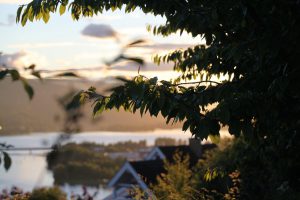
I’ve always cared about peace-making and reconciliation, and this is the story of how the Summer School at the Lillehammer Nansen Academy and the University of Oslo offered a path, says Elena Levina.
My thesis was on “Conciliation procedure as a peaceful way to resolve international disputes and conflicts”. At this time the Chechen wars were in progress, and later, working at the state service, I realised that the respect of fundamental human rights, norms of international law, and the principles of democracy were only a formality on paper. Neither our state nor our society was ready to change. So I became a human rights activist and later, after graduating from Moscow International Human Rights School, a Human Rights trainer.

Volunteer work in Ukraine
When the war in Ukraine broke out I went to east Ukraine as a volunteer, delivering humanitarian aid to orphanages, nursing homes and mental hospitals in an armed conflict area. Realising my own civic responsibility, I tried to re-establish connection between the Ukrainians and, coming back home, with Russians. I tried to tell them what was really happening. I tried to fix the representation of the other as an “enemy”, something that permeates both the Russian and Ukrainian propaganda.
Last summer I worked with the BUR organisation (“Building Ukraine Together”, Lviv Catholic University), repairing the houses of civilians who’d had their homes destroyed during the bombings. I met a lot of wonderful people in Ukraine, listened to and collected their stories, and took pictures. Besides their logical and justified mistrust, injure and trauma, they all just wanted peace and safety. Sometimes it was hard to reach normal communication (my accent immediately told everyone I’m Russian, and in the front line areas I showed my passport at checkpoints, so people were aware that I’m Russian volunteer). At the beginning most of them saw me as part of the conflict. They believed that 86% of Russians dream about the destruction of Ukraine as an independent state, and that all Russians support the occupation of Crimea and so on.
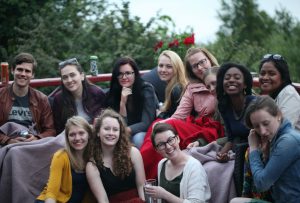
Breaking the ice with Ukrainians
At the beginning the Ukrainians were reluctant to communicate. They switched to Ukrainian which I did not understand, and this resulted in tensions. But I tried to learn Ukrainian, quite clumsily – and it broke the ice. Step by step, through dialogue and through working together, we started to communicate and found common ground. We were the same! Our life, troubles and wishes were absolutely the same. The shared physical work of restoring the bombed houses brought us together, and it turned out that people from any part of Ukraine has excellent Russian. And for convenience of work (to pass the tools, to explain how to spackle walls better), we just needed a common language. So in each new place, be it a village or a city, at first I always felt like a stranger who has to justify himself, as if I was party to the conflict. But in the process of communicating the ice melted, and everyone saw that we are all just people, working together, building our own peace, and that politics is one thing, but human interaction and help is another.
Moreover, the resolution of this conflict (seeing beyond our stereotypes) through shared work really brought us closer together. My Ukrainian friends are still very dear to me. Last December a few Ukrainian activists who used to say that they never want to see Russians again visited me in Moscow and took part in my course studies, telling my students about Human Rights violations on the “occupied territories”.
Seems like because this friendship was achieved through such resistance, and was based not only on a common understanding of the situation and common interests, but also on overcoming ourselves, our stereotypes, fears and prejudices through the traumas – it became much stronger and valuable.
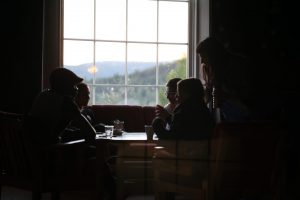
Where and how to begin peacebuilding in Russia
I returned home with hands-on experience and even stronger will to work on educating the Russian civil society on peacebuilding. I considered the best way to resist propaganda and to implement human rights and anti-war principles would be to popularise them through civil education, starting with schools and civil society. But I simply had no idea – HOW. How to reach this goal?
At the moment we have no peace education at all in Russia. We do have very rare educational seminars and trainings on Human Rights, held by a few volunteer trainers. A very few activities held by a small number of enthusiasts and volunteers. None of them are supported by the state, although right now preventing and overcoming crises related to various internal conflicts, wars, intolerance, refugee crisis, etc nonviolently is one of the most important issues we have. To let more people know that conflicts, difficulties and contradictions can be solved not only through force, and to better understand the alternatives – people just need to listen to each other! All popular history teaches us that conflict issues has always been revealed by war and violence, but peacekeeping education can offer an alternative path of nonviolence. It is all about dialogue in a broad sense. It is about the ability to transform a conflict and achieve positive change without violence. Using the ability to communicate, to hear, understand and respect each other. To promote the culture of peace, intercultural and interethnic dialogue, and this option should be available for everyone. Especially for people who work as educators of human rights, equality, freedom, non-violence, freedom of speech etc, and for students and youth. I used to teach students in the Moscow Cinema School, and most of them could hardly name two fundamental human rights and had never heard about the European Convention or UN.
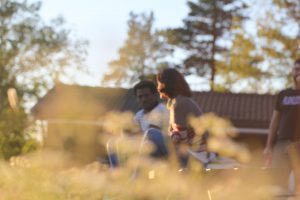
What we do is quite an immature effort. We need to work harder, be better equipped and more experienced. I feel that what we do now is not enough, even in the current circumstances. We have a network of young human rights activists working in the different fields of international solidarity; peacemaking, public meetings, courts and prisons observers, journalists, people working with advocacy and human rights trainers. But without knowledge we now walk separately in the dark, cautiously, intuitively searching for the ground under our feet.
But sometimes, when you step on the right path, it will lead you somewhere you belong.
The turning point

As an amateur operator of short movies about activists, on a human rights festival I heard about a famous “Reunion” movie and had a chance to see it. I was completely fascinated and I decided to show it to the wider public. After receiving funds for the project from from the Norwegian Helsinki Committee and House of Human Rights in Chernigov, I, along with a number of volunteers, invited Goran Lojancic (the Nansen Dialogue Network member and Balkan peacemaker) to Moscow. He presented “Reunion. 10 years after the war”, and ran a brief training on dialogue processes for all our activists and facilitators. A couple of friends from Kiev also came to Moscow to participate in the dialogue, and we had a skype conference with peace activists from Kiev. I guess it was a perspective step for our countries, which (de facto) are at war now.
During this session Goran Lojancic told us about the Nansen Academy and the summer school program at the University of Oslo. I immediately applied and passed, and those were the best four weeks of my life! In Lillehammer myself and five other russian activists met with student groups from USA, from Ukraine, and from the Balkans. A miniature construction of societies and people who had faced armed conflict. We asked each other uncomfortable questions and respectfully listened to the answers, perhaps for the first time. In this quiet, secluded and peaceful space, people with their own very deep and painful experience could meet, look into each other’s eyes, get to know each other and even make friends! We became very close and still keep in touch. Seems the Nansen Academy gave us invisible threads with which we are all now intertwined. We poured them into our hearts and brought them with us, weaving together a network of peace and friendship on different continents.
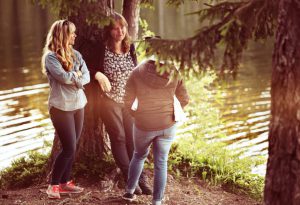
The same things happened in the Oslo summer school, where I studied peace research after leaving Lillehammer. In the Oslo summer school I met 28 great professionals in different spheres of peace research. We came from 21 different countries, we all had a hundred different opinions and a shared interest in peace. I felt I was part of a clan. Every day we read from the course’s compendium, and met with specialists and practitioners in different aspects of peace work, such as gender equality, environmental issues, migration and the refugee crisis, as well as peacebuilding in Colombia after the peace agreement. And we had a wonderful cabin trip to the mystery forests of Nordmarka, where we met with another dialogue facilitator from Nansen Centre. It was Norunn Grande, a fantastic person who shared her work experience from Afghanistan.
I’ve met so many interesting, fantastic people and received knowledge that I needed. Now I’m planning to continue my research, share it with my community, and hopefully make new, joint projects on international dialogue, where I can connect active and creative young Russians with foreign youth.
There’s a long way ahead and a lot of ideas and inspiration. That is exactly how happiness looks like, I guess…